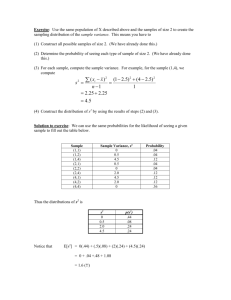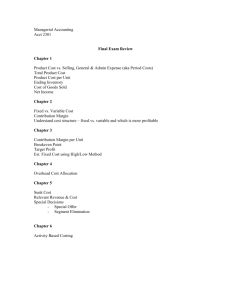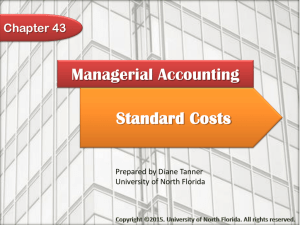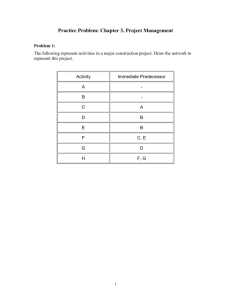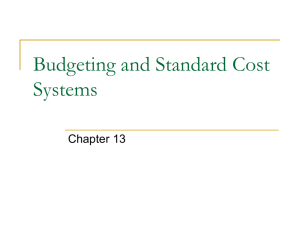Chapter 22
advertisement
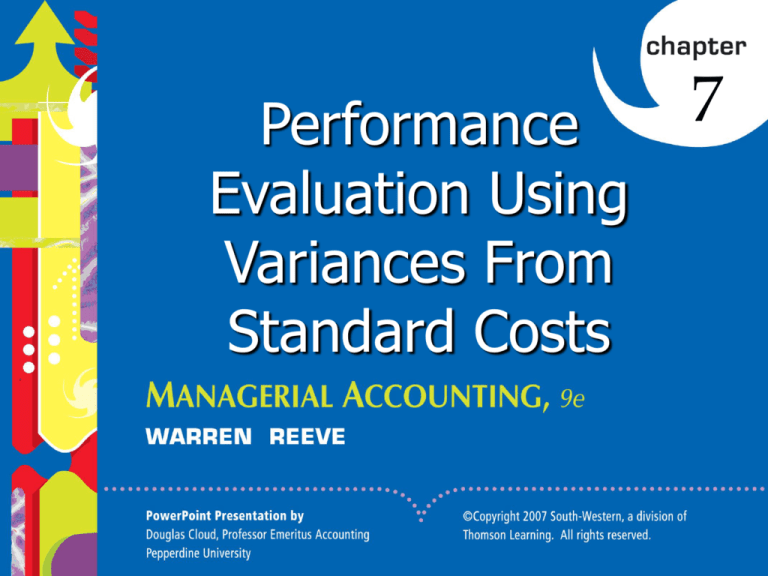
1 Click to edit Master title style Performance Evaluation Using Variances From Standard Costs 7 1 2 Standards Click to edit Master title style 7-1 Standards are performance goals. Manufacturers normally use standard costs for each of the three manufacturing costs: Direct materials Direct labor Factory overhead 2 3 Standard Cost for XL Jeans Click to edit Master title style 7-2 3 16 4 Budget Performance Report Click to edit Master title style 7-2 4 19 5 Relationship of Variances to the Total Manufacturing Cost Variances Click to edit Master title style 7-2 5 20 6 Direct Materials Click to edit Master title style Standard square yards per pair of jeans Actual units produced Standard square yards of denim budgeted for actual production Standard price per sq. yd. Standard direct materials cost at actual production 7-3 1.50 sq. yards x 5,000 pairs of jeans 7,500 sq. yards x $5.00 $37,500 6 22 7 Direct Materials Price Variance Click to edit Master title style 7-3 Actual price per unit $5.50 per sq. yd. Standard price per unit 5.00 per sq. yd. Price variance (unfavorable) $0.50 per sq. yd. $0.50 times the actual quantity of 7,300 sq. yds. = $3,650 unfavorable 7 23 8 Direct Materials Quantity Variance Click to edit Master title style Actual quantity used Standard quantity at actual production Quantity variance (favorable) 7-3 7,300 sq. yds. 7,500 (200) sq. yds. (200) square yards times the standard price of $5.00 = ($1,000) favorable 8 24 9 7-3 Click to edit Master title style Example Exercise 7-1 Tip Top Corp. produces a product that requires six standard pounds per unit. The standard price is $4.50 per pound. If 3,000 units required 18,500 pounds, which were purchased at $4.35 per pound, what is the direct materials (a) price variance, (b) quantity variance, and (c) cost variance? 9 27 10 7-3 Click to edit Master title style Follow My Example 7-1 a. Direct materials price variance (favorable) ($2,775) [($4.35 – $4.50) x 18,500 pounds] b. Direct materials quantity variance (unfavorable) $2,250 [(18,500 pounds – 18,000 pounds) x $4.50] c. Direct materials cost variance (favorable) ($525) [($2,775) + $2,250] or[($4.35 x 18,500 pounds) – ($4.50 x 18,000 pounds)] = $80,475 – $81,000 1028 For Practice: PE7-1A, PE7-1B 11 Direct Labor Variances Click to edit Master title style Standard direct labor hours per pair of XL jeans Actual units produced Standard direct labor hours budgeted for actual production Standard rate per DLH Standard direct labor cost at actual production 7-3 0.80 direct labor hour x 5,000 pairs of jeans 4,000 direct labor hours x $9.00 $36,000 11 29 12 Direct Labor Rate Variance Click to edit Master title style 7-3 Actual rate $10.00 Standard rate 9.00 Rate variance—unfavorable $ 1.00 per hour $1.00 times the actual time of 3,850 hours = $3,850 unfavorable 12 30 13 Direct Labor Time Variance Click to edit Master title style Actual hours Standard hours at actual production Time variance—favorable 7-3 3,850 DLH 4,000 (150)DLH (150) Direct labor hours times the standard rate of $9.00 = ($1,350) favorable 13 31 14 7-3 Click to edit Master title style Example Exercise 7-2 Tip Top Corp. produces a product that requires 2.5 standard hours per unit at a standard hourly rate of $12 per hour. If 3,000 units required 7,420 hours at an hourly rate of $12.30 per hour, what is the direct labor (a) rate variance, (b) time variance, and (c) cost variance? 14 34 15 7-3 Click to edit Master title style Follow My Example 7-2 a. Direct labor rate variance (unfavorable) $2,226 [($12.30 – $12.00) x 7,420 hours] b. Direct labor time variance (favorable) ($960) [7,420 hours – 7,500 hours) x $12.00] c. Direct labor cost variance (favorable) ($1,266) [$2,226 + ($960)] or [($12.30 x 7,420 hours) – ($12.00 x 7,500 hours)] = $91,266 – $90,000 15 35 For Practice: PE7-2A, PE7-2B 16 The Factory Overhead Flexible Budget Click to edit Master title style 7-4 Variances from standard for factory overhead result from: 1. Actual variable factory overhead cost greater or less than budgeted variable factory overhead for actual production. 2. Actual production at a level above or below 100% of normal capacity. 16 17 Variable Factory Overhead Controllable Variance Click to edit Master title style 7-4 Actual variable factory overhead $ 10,400 Budgeted variable factory overhead for actual amount produced (4,000 hrs. x $3.60) 14,400 Controllable variance— favorable $ (4,000) F 17 39 18 7-4 Click to edit Master title style Example Exercise 7-3 Tip Top Corp. produced 3,000 units of product that required 2.5 standard hours per unit. The standard variable overhead cost per unit is $2.20 per hour. The actual variable factory overhead was $16,850. Determine the variable factory overhead controllable variance. 18 40 19 7-4 Click to edit Master title style Follow My Example 7-3 $350 unfavorable $16,850 – [$2.20 x (3,000 units x 2.5 hours)] 19 41 For Practice: PE7-3A, PE7-3B 20 7-4 Fixed Factory Overhead Volume Variance Click to edit Master title style 100% of normal capacity 5,000 direct labor hours Standard hours at actual production 4,000 Capacity not used 1,000 direct labor hours Standard fixed overhead rate x $2.40 Volume variance—unfavorable $ 2,400 U 20 42 21 7-4 Click to edit Master title style Example Exercise 7-4 Tip Top Corp. produced 3,000 units of product that required 2.5 standard hours per unit. The standard fixed overhead cost per unit is $0.90 per hour at 8,000 hours, which is 100% of normal capacity. Determine the fixed factory overhead volume variance. 21 44 22 7-4 Click to edit Master title style Follow My Example 7-4 $450 unfavorable $0.90 x [8,000 hours – (3,000 units x 2.5 hours)] 22 45 For Practice: PE7-4A, PE7-4B 23 Reporting Factory Overhead Variances Click to edit Master title style Total actual factory overhead Factory overhead applied (4,000 hours x $6.00 per hour) Total factory overhead cost variance—favorable 7-4 $22,400 24,000 $(1,600) F 23 46
